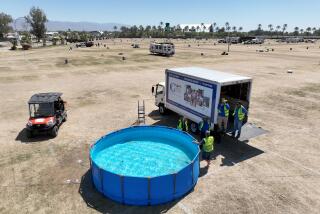Census: O.C. Urban, Not Suburban
Job and population growth during the 1990s helped fuel a big shift in one of the basics of Southern California life: where people travel to work each day.
Data on commuting patterns from the 2000 census, released in a report today, show that Orange County is continuing to mature economically, further leaving behind its traditional role as a bedroom community to Los Angeles.
Similar trends are emerging in Riverside and San Bernardino counties, where increasing numbers of residents are staying in their home counties for work.
The Census Bureau figures, which are estimates based on long-form surveys completed by selected households, show that Orange County is attracting more commuters from Los Angeles, Riverside and San Bernardino counties than a decade earlier. At the same time, Los Angeles County attracts fewer workers and exports more commuters to surrounding counties than in 1990.
The census estimates that the number of Los Angeles County residents commuting to Orange County for work rose by more than 19,000 to about 160,000, while those going in the reverse direction dropped by about 18,000 to more than 185,000.
At the same time, the number of Orange County residents working in their home county rose by more than 47,000, to about 1.1 million.
The number of Los Angeles County residents commuting to adjoining counties increased slightly -- by about 37,000 -- while the number of inbound commuters dropped by about 27,000.
In percentage terms, one of the largest shifts occurred in the flow of commuters into Ventura County from Los Angeles County -- up 35% during the 1990s to nearly 32,000.
Changes in job and housing markets mean predictable suburban patterns are eroding, said Jack Kyser, chief economist for the Los Angeles County Economic Development Corp.
“Ventura County [real estate] has become rather expensive, so you have people who may work in Ventura County but find affordable housing in the west part of the Valley.”
Some figures in the census report clash with conventional wisdom.
For instance, they show only a slight increase in commuters from Riverside to Orange County, while separate transportation studies show a massive rise.
But the figures generally affirm patterns that planners say are the hallmarks of a regional economic engine becoming stronger as it expands outward.
One demographer described the phenomenon in biological terms, as a cell breaking off into separate entities as it reproduces.
The statistics also “raise questions about the whole perception that workers in the Inland Empire are coming [west] for jobs,” said William Gayk, director of Cal State Fullerton’s Center for Demographic Research.
In some ways, the census estimates affirm a decades-long national trend toward “edge cities,” the development of satellite enclaves of jobs and neighborhoods that serve as ancillary economic hubs to traditional urban centers.
But the shifts in Southern California seem to indicate a growing consolidation within the chaos of suburban sprawl.
Growth in commuter flow into Orange County “shows the growing economic independence of Orange County and it is another sign that the county is not suburban,” said Scott Bollens, a UC Irvine urban planning professor.
The data also indicate that Orange County needs to address its housing shortage to foster healthy economic growth, said Hasan Ikhrata, planning and policy director for the Southern California Assn. of Governments.
“This suggests that Orange County will continue to need more infrastructure to support the employment,” he said. “There is a need for housing.”
The changes also can be felt on the freeways, said Cypress City Councilman Tim Keenan, chairman of the Orange County Transportation Authority Board of Directors.
“On the San Diego Freeway every morning ... there are just as many people going south as going north,” he said. “It’s gridlock in both directions.”
Keenan said the shift is accelerating the need to complete highway projects -- such as the Garden Grove Freeway widening -- and to find alternatives to motor vehicles, such as light-rail systems, innovative uses for transit buses, and commuter rail operations such as MetroLink.
Economist Esmael Adibi, director of Chapman University’s Anderson Center for Economic Research, traced the changes to the 1960s, when Orange County evolved from an agricultural hub to the home of white-collar workers who could not afford to live in Los Angeles, where they worked.
Now that dynamic has shifted, and the Inland Empire is serving that role for Los Angeles and Orange counties as it develops its own economic base, parlaying relatively cheap open space into new industry and businesses.
“Usually business follows people,” Adibi said. “Over a number of years, business followed people to Orange County and gradually Orange County became a more mature, independent economy.... That trend will probably continue in the Inland Empire.”
Stan Oftelie, executive director of the Orange County Business Council, said he was not surprised by the shifting commute patterns.
For years, he said, a significant number of people have been coming into Orange County to work, a trend that is not likely to change any time soon.
“This is not the first census to show this,” Oftelie said. “Orange County as a bedroom community of Los Angeles has not been the case for a long time.”
And as Orange County has grown, so too will the Inland Empire, said Kyser.
“They are growing their own manufacturing base,” he said.
“And they’re getting to the size where we have lots of the business services firms setting up offices there instead of having people drive out from Los Angeles.”
*
Staff writer Ray F. Herndon contributed to this report.
More to Read
Start your day right
Sign up for Essential California for news, features and recommendations from the L.A. Times and beyond in your inbox six days a week.
You may occasionally receive promotional content from the Los Angeles Times.








